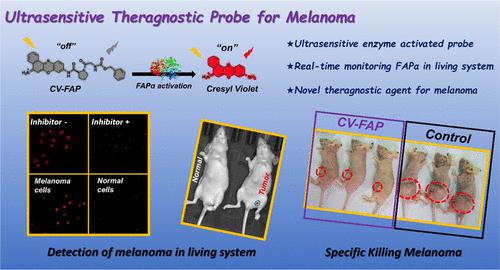Our official English website, www.x-mol.net, welcomes your
feedback! (Note: you will need to create a separate account there.)
Ultrasensitive Fibroblast Activation Protein-α-Activated Fluorogenic Probe Enables Selective Imaging and Killing of Melanoma In Vivo
ACS Sensors ( IF 8.2 ) Pub Date : 2022-06-17 , DOI: 10.1021/acssensors.2c00126 Shi-Yu Liu 1 , Huiling Wang 2 , Gang Nie 3
ACS Sensors ( IF 8.2 ) Pub Date : 2022-06-17 , DOI: 10.1021/acssensors.2c00126 Shi-Yu Liu 1 , Huiling Wang 2 , Gang Nie 3
Affiliation

|
Melanoma is a malignant cancer with a high risk of metastasis and continued increase in death rates over the past decades, and its prognosis is highly related to the disease’s stage, while early detection and treatment of melanoma are significant to the improvement of its therapy outcome. Different from the traditional methods for disease diagnosis, enzyme-activated fluorescent probes were developed rapidly due to their high sensitivity and temporal–spatial ratio and have been widely applied in tumor detection, surgical navigation, and cancer-related research. Fibroblast activation protein-α (FAPα), a serine-type cell surface protease that plays important roles in cell invasion and extracellular matrix degradation, is widely involved in tumor progression such as malignant melanoma, so developing a FAPα activity-based molecular tool would be of great potential for the early diagnosis and therapy of melanoma. However, few fluorescent probes targeting FAPα have been applied in melanoma-related studies, and thus, the construction of FAPα activity-based fluorescent probes for melanoma detection is in urgent need. By incorporating the selective recognition unit with a red-emission fluorophore, cresyl violet, we herein report an ultrasensitive (limit of detection = 5.3 ng/mL) fluorogenic probe for FAPα activity sensing, named CV-FAP; the acquired probe showed a significantly higher binding affinity (15.7-fold) and overall catalytic efficiency (2.6-fold) when compared with those of the best reported FAPα probes. The good performance of CV-FAP made it possible to discriminate malignant melanoma cells and tumor-bearing mice from normal cells and mice with high contrast. More importantly, CV-FAP showed significant antitumor activity toward melanoma in cultured cells and tumor-bearing nude mice (over 95% inhibited tumor growth) with good safety, which made it an ideal theranostic agent for melanoma.
中文翻译:

超灵敏的成纤维细胞激活蛋白-α-激活的荧光探针能够在体内选择性成像和杀死黑色素瘤
黑色素瘤是一种具有高转移风险的恶性肿瘤,近几十年来死亡率持续上升,其预后与疾病的分期密切相关,而黑色素瘤的早期发现和治疗对其治疗效果的改善具有重要意义。与传统的疾病诊断方法不同,酶激活荧光探针因其高灵敏度和时空比而得到迅速发展,并已广泛应用于肿瘤检测、手术导航和癌症相关研究。成纤维细胞活化蛋白-α(FAPα)是一种丝氨酸型细胞表面蛋白酶,在细胞侵袭和细胞外基质降解中起重要作用,广泛参与恶性黑色素瘤等肿瘤进展,因此,开发一种基于 FAPα 活性的分子工具对于黑色素瘤的早期诊断和治疗具有巨大的潜力。然而,针对 FAPα 的荧光探针很少用于黑色素瘤相关研究,因此,构建用于黑色素瘤检测的基于 FAPα 活性的荧光探针是迫切需要的。通过将选择性识别单元与红色发射荧光团甲酚紫结合,我们在此报告了一种用于 FAPα 活性传感的超灵敏(检测限 = 5.3 ng/mL)荧光探针,命名为CV-FAP ; 与报道最好的 FAPα 探针相比,获得的探针显示出显着更高的结合亲和力(15.7 倍)和整体催化效率(2.6 倍)。CV-FAP的良好性能使其能够以高对比度区分恶性黑色素瘤细胞和荷瘤小鼠与正常细胞和小鼠。更重要的是,CV-FAP在培养细胞和荷瘤裸鼠中对黑色素瘤具有显着的抗肿瘤活性(95%以上抑制肿瘤生长),安全性好,是治疗黑色素瘤的理想药物。
更新日期:2022-06-17
中文翻译:

超灵敏的成纤维细胞激活蛋白-α-激活的荧光探针能够在体内选择性成像和杀死黑色素瘤
黑色素瘤是一种具有高转移风险的恶性肿瘤,近几十年来死亡率持续上升,其预后与疾病的分期密切相关,而黑色素瘤的早期发现和治疗对其治疗效果的改善具有重要意义。与传统的疾病诊断方法不同,酶激活荧光探针因其高灵敏度和时空比而得到迅速发展,并已广泛应用于肿瘤检测、手术导航和癌症相关研究。成纤维细胞活化蛋白-α(FAPα)是一种丝氨酸型细胞表面蛋白酶,在细胞侵袭和细胞外基质降解中起重要作用,广泛参与恶性黑色素瘤等肿瘤进展,因此,开发一种基于 FAPα 活性的分子工具对于黑色素瘤的早期诊断和治疗具有巨大的潜力。然而,针对 FAPα 的荧光探针很少用于黑色素瘤相关研究,因此,构建用于黑色素瘤检测的基于 FAPα 活性的荧光探针是迫切需要的。通过将选择性识别单元与红色发射荧光团甲酚紫结合,我们在此报告了一种用于 FAPα 活性传感的超灵敏(检测限 = 5.3 ng/mL)荧光探针,命名为CV-FAP ; 与报道最好的 FAPα 探针相比,获得的探针显示出显着更高的结合亲和力(15.7 倍)和整体催化效率(2.6 倍)。CV-FAP的良好性能使其能够以高对比度区分恶性黑色素瘤细胞和荷瘤小鼠与正常细胞和小鼠。更重要的是,CV-FAP在培养细胞和荷瘤裸鼠中对黑色素瘤具有显着的抗肿瘤活性(95%以上抑制肿瘤生长),安全性好,是治疗黑色素瘤的理想药物。




















































 京公网安备 11010802027423号
京公网安备 11010802027423号